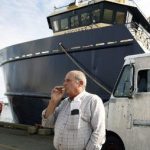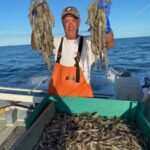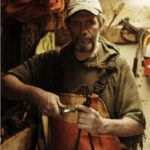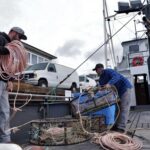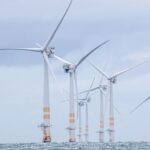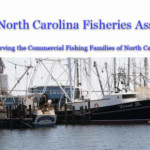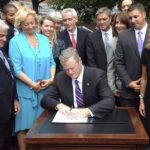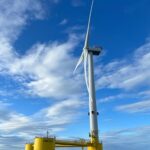COMPLAINT FOR REVIEW OF GOVERNMENTAL ACTION UNDER M.R. Civ. P. 80B
STATE OF MAINE
WASHINGTON COUNTY, ss.
SUPERIOR COURT
Civil Action
Docket No. AP-
PROTECT DOWNEAST, CYNTHIA
BEAUVAIS, KARL EBERT,
OWEN MOODY, AND CARRIE
PEABODY,
Plaintiffs,
v.
TOWN OF JONESPORT,
Defendant,
and
KINGFISH MAINE, INC.,
Party-in-Interest.
COMPLAINT FOR REVIEW OF
GOVERNMENTAL ACTION UNDER
M.R. Civ. P. 80B
Pursuant to Maine Rule of Civil Procedure 80B, plaintiffs Protect Downeast, Cynthia Beauvais and Karl Ebert, Owen Moody, and Carrie Peabody (collectively “Protect Downeast” or the “Plaintiffs”), by and through undersigned counsel, complains against defendant Town of Jonesport (the “Town”) for review of the decision by the Town’s Planning Board (the “Board”) to approve with conditions the application (the “Decision”) of party-in-interest Kingfish Maine, Inc. (the “Applicant”) authorizing them to construct and operate a recirculating industrial-scale aquaculture facility (“Industrial Aquafarm”) in the rural residential district and shoreland zone of
the Town (the “Project”).
Parties and Properties
1. Protect Downeast is a membership-based organization that represents a diverse coalition of Jonesport residents and business owners and their allies in nearby communities who oppose the Project, with many members providing written and oral testimony during the Board hearings.
Protect Downeast’s members are directly or indirectly involved in water dependent businesses including fishing, lobstering, clamming and tourism, all of whom will be negatively impacted by the Industrial Aquafarm.
2. Cynthia Beauvais (“Beauvais”) and Karl Ebert (“Ebert”) are members of Protect Downeast and residents of the Town who reside on real property located at 533 Mason Bay Road; their home has an unobstructed view of the Project and they are in the business of owning and renting properties located on Chandler Bay, overlooking the Project site; their home and all of their rental properties will be negatively impacted by increased truck traffic, industrial noise and the discharge of
pollution resulting from the Project, decreasing the value of their income properties and directly and negatively impacting their quiet enjoyment of their home.
3. Owen Moody (“Moody”) is a member of Protect Downeast; his business is as a lobster man in Chandler Bay and Englishman’s Bay. The potential pollution from the Industrial Aquafarm will have direct and negative impacts to the waters and living environment for the lobsters of the Bay, Mr. Moody’s business will suffer and cause economic harm to his family.
4. Carrie Peabody (“Peabody”) is a member of Protect Downeast; Peabody’s husband provides significant income for her family through his lobstering and clamming business near the Project. The potential for pollution and increased nitrogen levels negatively and directly impacting the clam flats that are directly outside the Peabody’s residence, and the lobstering areas in the Bays, will directly and negatively impact Mr. Peabody’s business causing financial harm to the Peabody family. Increased large scale commercial truck traffic will further directly and negatively impact the Peabody’s home causing further financial harm by de-valuing their property.
5. The Town is a municipality located in the County of Washington and State of Maine.
6. Upon information and belief, party-in-interest Kingfish Maine, Inc., is a Delaware corporation duly authorized to conduct business in Maine who filed an application (the “Application”) to construct and operate the Project on a portion of real property located on Natt Point, which is addressed as 9 Dun Garvin Road in the Town of Jonesport, County of Washington, and State of Maine and identified by the Town as Lot 23 on Tax Map 8 (the “Property”).
7. The Applicant owns the Property.
Facts
8. The Applicant filed its Application with the Town on June 30, 2022, seeking authorization under the Town’s Land Use and Development Ordnance (“LUDO”) and Shoreland Zoning Ordinance (“SZO”) to construct and operate the Project.
9. The Board voted to find the Application complete on July 19, 2022, no public hearing was
held on this date.
10. The Property is located in the Rural Residential District (“RRD”) and subject, in part, to the
Shoreland Overlay Zone (“SZ”).
11. The Applicant proposes to construct and operate a recirculating aquaculture system (“RAS”) on the Property in order to hatch, grow, process, and ship 6,000-8,000 tons of yellowtail kingfish on an annual basis.
12. The Property spans 93 acres and the Project involves construction of roads, several large buildings—the largest of which occupies approximately 9.7 acres—and other structures; in total, the Property will have an impervious surface area of 21.9 acres.
13. The Applicant’s proposed activity is a commercial installation, and the buildings onsite will be used for industrial and commercial purposes.
14. The Project will impact 261,196 square feet of freshwater wetlands, including 64,004 square feet of wetlands of special significance.
15. The Project also involves the construction of two intake pipes, each measuring 1,400 feet in length, and two outtake pipes, each measuring 2,800 feet in length and 4 feet in diameter, that will extend from the Property into Chandler Bay; the construction of these pipes alone will directly impact 7,136 square feet of coastal wetlands.
16. The intake pipes include two massive 14-foot-tall intake structures, through which the Applicant proposes to take in 19,812 gallons of seawater from Chandler Bay per minute.
17. This water will be used as part of the Applicant’s fish growing operation and will then be discharged back into Chandler Bay through the outtake pipes after passing through a mechanical filtration system and Outfall Diffusers.
18. In total, Applicant proposes to discharge up to 28.7 million gallons of pollutant per day into Chandler Bay, up to 6.5 million gallons of which will be fish culture or process water.
19. The fish culture and process water which the Applicant proposes to discharge includes suspended solids like phosphorous and nitrogen that may be present at levels above ambient conditions in Chandler Bay.
20. In total, the Applicant intends to discharge 1639 pounds of nitrogen and 393 pounds of phosphorous and some amount of formalin into Chandler Bay on a daily basis.
21. The DEP, in its review of the Project, determined the effect these discharges will have on Chandler Bay by considering among other facts, the impact of the nitrogen released on eelgrass.
22. According to the Discharge Permit, the background concentration of nitrogen present in Chandler Bay is 0.26mg/L; therefore, the maximum amount of remaining assimilative capacity which the Applicant can legally discharge without degrading the water quality of Chandler Bay is 20% or 2.1mg/L.
23. The Applicant proposes to discharge 6.6mg/L, which is far above the legal threshold, and will result in degradation of the water quality of Chandler Bay.
24. The Applicant also filed an application for and obtained a MEPDES permit, which was issued on June 25, 2021 (the “Discharge Permit”), and applications for permits under NRPA (the “NRPA Permit”) and SLODA (the “SLODA Permit”), both of which the Department of Environmental Protection (“DEP”) issued on November 12, 2021 and are currently subject to an appeal before the Superior Court.
25. The DEP found that the Applicant had therefore triggered the anti-degradation provision threshold of 20% of the remaining assimilative capacity for their discharge and that the Applicant’s operation of the Industrial Aquafarm will result in a lowering of existing water quality as it relates to eelgrass as an indicator for nitrogen.
26. Despite these express findings, the DEP still issued the Discharge Permit because the DEP was required under 38 M.R.S.A. § 464(F)(5) to consider whether it believed that the Industrial Aquafarm would achieve important economic or social benefits to the State.
27. Pursuant 38 M.R.S.A. § 464(F)(5), the DEP found, based on flawed economic analysis provided strictly on behalf of Kingfish, that the potential economic benefits of the Industrial Aquafarm offset the environmental harm.
28. There is no equivalent statute or provision in the LUDO or SZO that provided the Board the authority to approve the Application despite the fact the Project will result in a lowering of existing water quality as it related to eelgrass as an indicator for nitrogen.
29. The Board held two public hearings on the Applicant’s compliance with the LUDO on August 2, 2022, and on August 25, 2022.
30. On August 25, 2022, the Board voted to find the Application satisfied the standards in the LUDO and on November 29, 2022, the Board adopted the Land Use and Development Ordinance Findings and Conclusions (the “LUDO Findings”) as the grounds for its conclusion that the Project satisfied the LUDO.
31. The Board held four public hearings on the Applicant’s compliance with the SZO between
September 1, 2022, and October 20, 2022.
32. The Board voted to close the public hearing on the Application on October 20, 2022, and on November 29, 2022, the Board voted to adopt the Shoreland Zoning Ordinance Findings & Conclusions (the “SZO Findings”).1
33. The purported grounds for the Decision are contained in the LUDO findings and the SZO findings.
34. Because the Property is located within the RRD, the activity the Applicant intends to engage in on that land must not be prohibited by LUDO § 15; otherwise, the Board lacks the authority to approve the Application.
35. LUDO § 15.19 permits marine related activities that qualify as functionally water-dependent uses, but prohibits principal commercial structures and industrial structures in the RRD.
36. Under LUDO § 11, where provisions of this Ordinance conflict with the provisions of other regulations or ordinances, whichever imposes the more stringent restrictions shall prevail.
37. Despite these provisions of the LUDO, the Board found that the Industrial Aquafarm was a permitted use in the RRD and failed to recognize that the buildings Applicant proposes to construct on the Property are commercial and industrial in nature.
38. Under SZO § 15.R, “no activity shall deposit on or into the ground or discharge to the waters of the State any pollutant that . . . will impair designated uses of the water classification of the water body.”
39. Chandler Bay is a class SB marine waterbody; “[c]lass SB waters must be of such quality that they are suitable for the designated uses of recreation in and on the water, fishing, aquaculture, propagation and harvesting of shellfish, industrial process and cooling water supply, hydroelectric power generation, navigation and as habitat for fish and other estuarine and marine life.”
40. Despite the DEP’s finding that the water quality of Chandler Bay will be degraded by the discharges from the Industrial Aquafarm and that the designated uses of Chandler Bay would be impaired, nevertheless the Board found that the Applicant met the water quality standards in the
SZO.
41. SZO § 16.D.7 states that “[a]fter the submission of a complete application to the Planning Board, the Board shall approve an application or approve it with conditions if [the Board] makes a positive finding based on the information presented that the proposed land use . . . will not adversely affect existing commercial fishing or maritime activities in a Commercial Fisheries/ Maritime Activities District.”
42. The DEP expressly found that the diffuser, intake and discharge structures, and concrete anchoring collar structures proposed by the Applicant as part of the Project, could have adverse effects on commercial fishing.
43. The DEP also found that the 1639 pounds of nitrogen released by the Industrial Aquafarm every day will have a direct, negative impact on eelgrass, an essential part of a healthy commercial fishery.
44. Because of the high probability that the Industrial Aquafarm will make it more difficult to fish and trap in Chandler Bay, the commercial activities located in Commercial Fisheries/Maritime Activities District are likely to be harmed by the Industrial Aquafarm.
45. Despite these findings, the Board found this standard not to apply because the Project is not located in the Commercial Fisheries/ Maritime Activities District.
Complaint for Review of Governmental Action
46. Protect Downeast hereby incorporates by reference the allegations asserted in all paragraphs set forth above with the same effect as if set forth in full herein.
47. The Board’s Decision to approve the Project under the LUDO and SZO was arbitrary, capricious, legally erroneous, and unsupported by evidence for the following reasons, among others:
a. The Board erred as a matter of law by misinterpreting LUDO § 15 to treat “marine-related activities,” “commercial structures” and “industrial structures” as
mutually exclusive categories.
b. The Board erred as a matter of law by finding that Applicant satisfied the LUDO and that an Industrial Aquafarm is a permitted use within the RRD, despite the
prohibition of construction of industrial and commercial structures in the RRD contained in LUDO § 15.
c. The Board erred as a matter of law by misinterpreting the water quality standard, § 15.R of the SZO— which prohibits activity that deposits into the waters of the
State any pollutant that will impair designated use of the water classification of the water body—to allow approval of the Project despite an explicit finding by the DEP that the Industrial Aquafarm will discharge pollutants into Chandler Bay that will impair the designated uses of that water body.
d. The Board erred as a matter of law by misinterpreting § 16.D.7 of the SZO, which prohibits activities that will adversely affect existing commercial and
maritime activities in the Commercial Fisheries/ Maritime Activities District, by finding that this standard not to apply because the Project is not located in the
Commercial Fisheries/ Maritime Activities District.
1 Pursuant to LUDO § 9.E and SZO § 16.G.3.1, and Town of Jonesport Board of Appeals Ordinance, all of the named Plaintiffs timely filed an administrative appeal to the Jonesport Board of Appeals (“BOA”), thereby satisfying the administrative pre-requisite to filing this 80B complaint. The BOA held on the record hearings and subsequently issued its written decision affirming the Planning Board’s Decision on March 7, 2023, marking the start of the 30-day deadline for filing this appeal. The BOA’s Decision is not the operative decision before this Court but it is part of the record on appeal.
WHEREFORE, Plaintiffs respectfully request that the Court enter judgment vacating the Decision and remanding this matter to the Board with instructions to deny the Application. Dated: April 6, 2023.
________________________
Elizabeth A. Boepple, Bar No. 4422
[email protected]
Sean R. Turley, Bar No. 6351
[email protected]
Ellen P. Masalsky, Bar No. 10307
[email protected]
Counsel for plaintiff Protect Downeast
MURRAY PLUMB & MURRAY
75 Pearl Street, P.O. Box 9785
Portland, Maine 04104-5085
(207) 773-5651

































